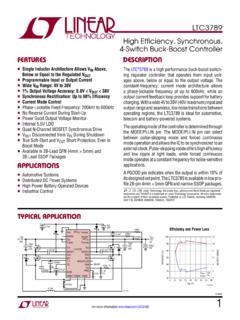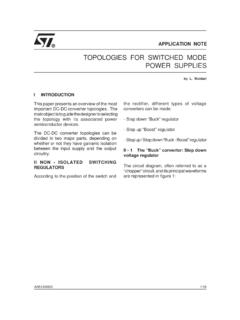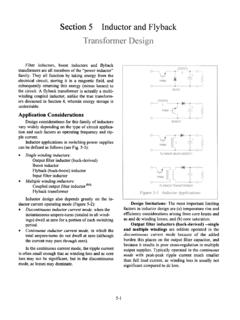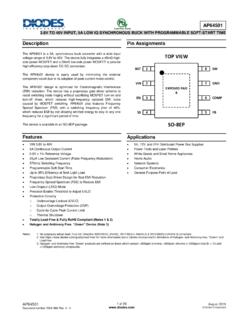Transcription of Snubber Circuits: Theory , Design and Application - TI.com
1 May 93 Snubber Circuits: Theory , Design and ApplicationPhilip C. ToddPassive Snubber TypesThe basic function of a Snubber is to absorbenergy from the reactances in the power fIrst classification of Snubber circuits is wheth-er they absorb energy in controlling a voltage or acurrent. A capacitor placed in parallel with othercircuit elements will control the voltage acrossthose elements. An inductor placed in series withother circuit elements will control the currentthrough those elements. Figure I shows this con-cept. A voltage Snubber (Fig. la) has energy stor-age capacitors in it and a current Snubber (Fig. Ib)has inductors for energy storage. The networksassociated with the inductor and capacitor shown inFigure I determine how energy is passed to thestorage element and how the energy is removedfrom itAll of the otherclassifications of snub-berg relate to the waysin which the energy istransferred to and fromthe Snubber .
2 If theenergy stored in thesnubber is dissipated ina resistor the Snubber isclassed as dissipativebut if the energy ismoved back to the inputor ahead to the outputthe Snubber is classedas non-dissipative eventhough there may besome small losses. Asnubber is classed aspolarized or non-polar-ized depending onIntroductionSnubbers are an essential part of power electron-ics. Snubbers are small networks of parts in thepower switching circuits whose function is tocontrol the effects of circuit enhance the performance of the switch-ing circuits and result in higher reliability, higherefficiency, higher switching frequency, smaller size,lower weight, and lower EMI. The basic intent ofa Snubber is to absorb energy from the reactiveelements in the circuit . The benefits of this mayinclude circuit damping, controlling the rate ofchange of voltage or current, or clamping voltageovershoot. In performing these functions a snubberlimits the amount of stress which the switch mustendure and this increases the reliability of theswitch.
3 When a Snubber is properly designed andimplemented the switch will have lower averagepower dissipation, much lower peak power dissipa-tion, lower peak operating voltage and lower peakoperating current. This article describes some of thevarious types of snubbers, where they are used,how they function, how they are designed and whattheir limitations may be either passive or active article is limited to the main types of passivesnubbers. Passive Snubber network elements arelimited to resistors, capacitors, inductors and snubbers include transistors or other activeswitches, often entail a significant amount of extracircuitry and introduce another level of parasiticswhich must be dealt with (usually with a passivesnubber). However, active snubbers are appropriatein some applications . A good example of an activesnub is what you would like to say to your bosswhen he or she decides not to give you a lb2-1 Snubber Circuitswhether energy moves in or out of the Snubber onone edge of the switching waveform or both.
4 Thelast classification for Snubber circuits is rate of riseof voltage or voltage clamping. Current snubbersare all rate of rise control types as there is nopassive current limiting device available yet. volt-age snubbers l1 Jay clamp a voltage to a fixed orvariable level or may control the dV/dt of are often used in combinations and agiven Application may have two or three snubbersmerged into one network to control both the currentand voltage of the I is an applications guide and it gives abreakdown of the basic Snubber types and theiruses. The simple damping snubbers are dissipativeby definition. Rate of rise control and voltageclamp snubbers may be either dissipative or non-dissipative. Non-dissipative snubbers are morecomplex than dissipative snubbers but this complex-ity is justified when the power dissipation is toohigh or the efficiency is too I -QUICK GUIDE TO Snubber circuit USAGET able 2 is an index to the Snubber circuits de-scribed in this article and gives the page numberthat the description of that Snubber begins in Snubber OperationSnubbers have a duality which is a drawback insome applications .
5 A Snubber which controls theswitch voltage at turn off will create a current pulsein the switch at turn on. A Snubber which controlsthe switch current at turn on will create a voltagepulse across the switch at turn with alternating switches, such as apush-pull converter, with a voltage Snubber on oneswitch to control the voltage at turn off will have acurrent spike in the other switch when it turns same is true for snubbers on the output diodesof a converter. Some diodes are driven off by theswitches and others are driven on so if a Snubber isnot properly designed it will present a low imped-ance to the switches when they are turning on andresult in a large current FundamentalsEach Snubber in this discussion will be shown inan example circuit which is as generic as 2 shows the basic buck , boost and flybackconverter circuits drawn so that the switch is alwaysgrounded. The figures which follow will generallyshow a Snubber in relation to a generic groundedswitch so Figure 2 may be used to apply the snub-ber to most other topologies.
6 In this approach theswitch and the Snubber may be thought of as asingle unit, a snubbed switch, which may be usedRATE OF R~gQ~JROL SNUBBERS~--reduce power dissipa~on and stress in switch at turn-off--prevent overshoot and ringing by not exci~ng resonance--reduce EMI by reducing high frequency noiseCurrent--reduce power dissipanon and stress in switch at turn-on--reduce diode reverse recovery currentVOLTAGE CLAMPT able II .INDEX TO Snubber CIRCUITS--reduce peak switch voltage--reduce peak switch power dissipauon at turn-off--reduce ringing at switch turn-offDissipa~ve Snubbers Simple RC Voltage SnubberRCD Voltage Snubber ..Simple RL Current Snubber3359 DAMPING~--reduce overshoot and ringing at switch tum-olf--reduce switch power dissipation--reduce EMIC urrent10101112131315 Non-dissipanveSnubbers Two Voltage Snubber . Three TerminaI3D-2C-1L Voltage Snubber . Three Terminal Voltage Snubber with Intermediate VoltageFlyback Reset Current Snubber .
7 Resonant Recovery Current Snubbers TransformerResetVoltageClamp c c--reduce overshoot and ringing at switch turn-on--reduce power dissipauon in switch--reduce EMIRate of rise control snubbers and voltage clamp snubbers may be eitherdissipative or non-dissipative. Non-dissipauve snubbers reduce the pow-er dissipauon of the Snubber and increase the efficiency of the CORPORATIONL~DoLoI-r-;=-CoRLv-=-Q~BUCKrl ~DoLo~I4--vQ I, -~ boost -"CoRL~DoLo~I-4----=-vQswitch for a particular purpose. An inductor inseries with the switch, a comnt Snubber , presentsthe switch with an inductive load at turn-on so thatit switches on with zero comnt. This is a modifi-cation of the load which would typically be some-what capacitive at turn-on. The same is true at turn-off with a voltage Snubber . At turn-off the load onthe switch will typically look inductive so a capaci-tor in shunt with the switch, a voltage Snubber , willchange the load line to be capacitive so that theswitch can turn off at zero Voltage SnubbersDissipative snubbers are those which dissipatethe energy they absorb in a resistor.
8 Dissipativesnubbers may be either voltage or current snubbersand may be either polarized or non-polarized. Dissi-pative snubbers may be designed to control the rateof rise of voltage or current or be designed toclamp the RC Voltage Snubber : The simple RCsnubber shown in Figure 3A provides damping ofthe parasitic resonances in the power stage and isprobably the most widely used of all snubbercircuits. It is used on output inductors and thesecondaries of transformers as well as across diodesand switches. It is applicable both to rate of risecontrol and to damping. The simple RC Snubber isone of few snubbers which is effective in theclassic push-pull switch 3B shows the RC Snubber applied to thegeneric switch circuit . As discussed above thegeneric switch circuit is a clamped inductive loadso in the idealized form shown here there are noparasitic resonances to damp. In this case the RCsnubber may be used to reduce the peak powerdissipation in the switch.
9 If the values of R and Care chosen correctly the switching losses can bereduced by up to 40% including both the loss in theswitch and the loss in the resistor over the completeswitching cycle[l].The main Application of an RC Snubber is damp-ing the resonance of parasitic elements in the powercircuit. In applications where damping is requiredthe value of the resistor must be close to theimpedance of the parasitic resonance which it isintended to damp. The Snubber capacitance must bein almost allsnubbers areapplicable toa particularproblem. Thecircuits inFigure 2 areall c lam pedinductiveloads andthese circuitsdo not needvoltage clampsnubbers sincethat functionis inherent inthe snubbers Iwhich are Iappropriate inthese topolo- Igies are volt-age and cur- Irent rate of Lrise YBACK ontro mgthe rate of Fig 2a. b. crise of voltage and current and clamping the voltageand controlling resonances reduces the stress on theswitch.
10 Snubbers can control the voltage and currentto the point where switching occurs at zero voltageand zero current and this raises the reliability of thepower stage significantly. Taken to the extreme,zero voltage and current switching becomes reso-nant power conversion. This becomes necessarywhen the circuit parasitics become large relative tothe power level. High voltage outputs are oneexample. In most cases, however, the optimumefficiency level is reached with small snubbers longbefore a full resonant approach is necessary .The effect of a Snubber on the switch may beviewed as changing, or shaping, the load line on the2-3 Snubber CircuitsR1 LLo~+-:C1Q1-Rtt"'"LLo, the impedance of the parasitic resonant circuit isknown. The value of inductance is usually theleakage inductance of the transfonDer and can beestimated with some effort. The resistor value is setequal to the resulting characteristic is always good practice to estimate the valuesneeded fIrst since a calculated value which isgrossly in error indicates that either the circuit isnot built as designed or was not designed as the circuit has been built and is operating,the values of the Snubber components may be opti-mized experimentally.














